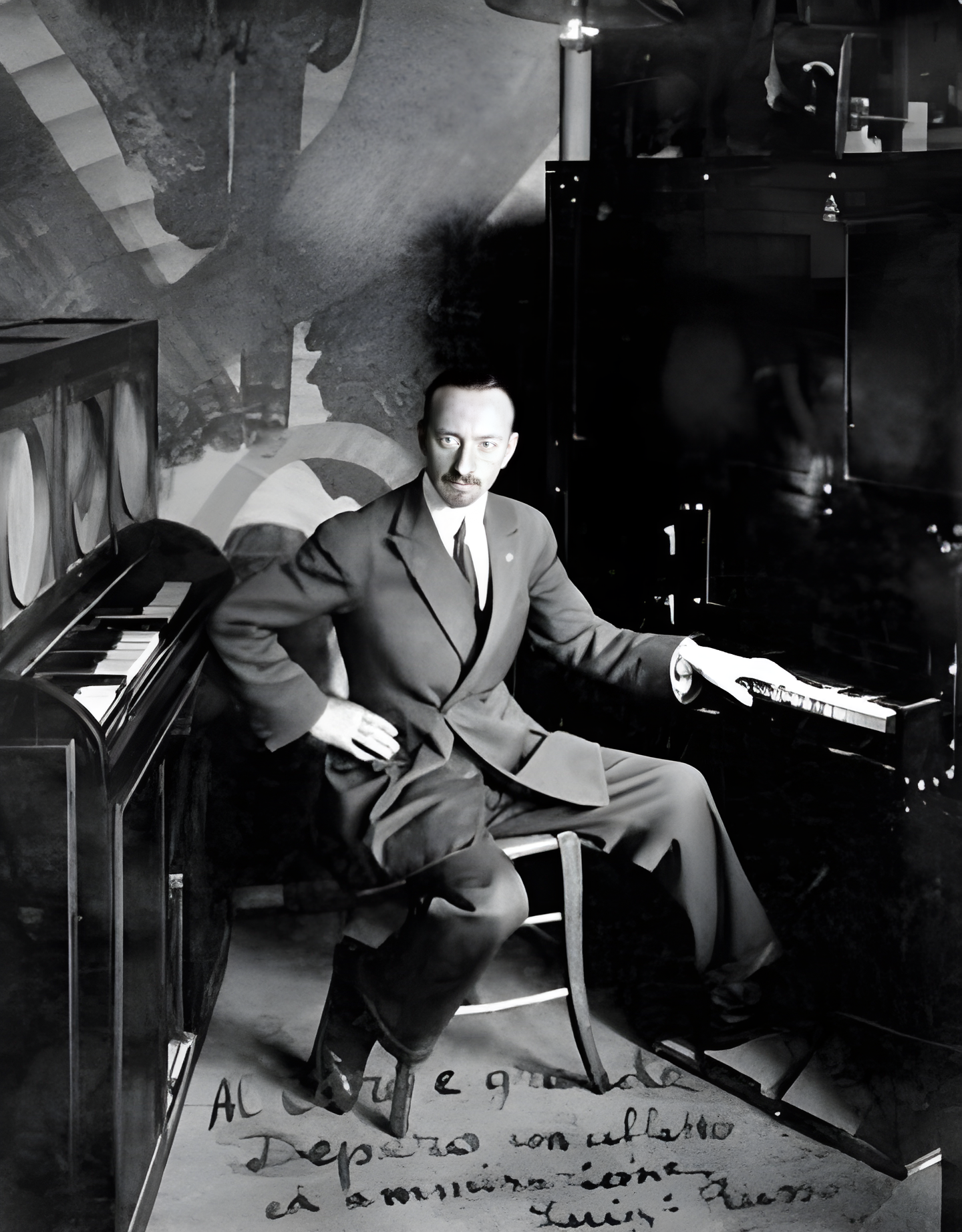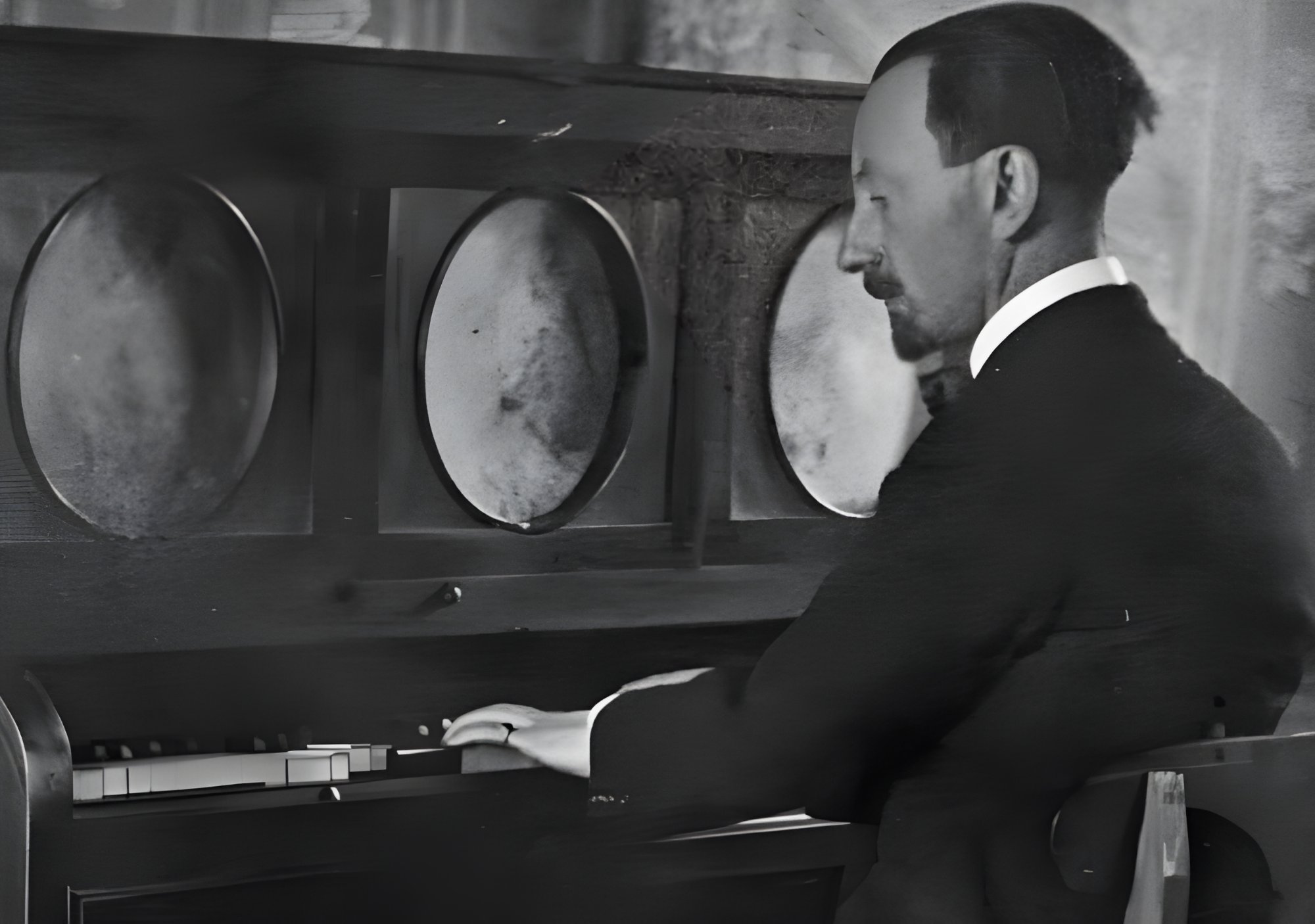> Mag > Vie Culturelle > Luciano Chessa, AI and italian Futurism

Care, Annecy
Luciano Chessa, AI and italian Futurism
EntretienAll the versions of this article: [English] [français]
We had the opportunity to interview Luciano Chessa in Annecy in the old town at the CARE premises and we did not miss it. The unique opportunity to interact with this immense composer, conductor, audiovisual and performance artist, historian of futurist music and noise maker Luigi Russolo.
Luciano Chessa is the author of “Luigi Russolo Futuriste” (2012), the first book devoted to the Art of noises and Luigi Russolo’s relationship with the occult sciences. He is also the author of “Gay Guerilla”, both works having received unanimous critical acclaim.
In 2009, his ”Orchestra of Futurist Noise Intoners (OFNI)” was considered one of the best events of the year by the New York Times. For this project he collaborated with Joan La Barbara, Mike Patton, Lee Ranaldo, Ellen Fullman, Blixa Bargeld, Pauline Oliveros, among others.
Chessa’s prolific compositions include ’Cromlech’, a large organ piece which he premiered at Melbourne Town Hall in May 2018 as part of a solo organ recital, the opera ”Cena oltranzista nel castelletto al lago” — a work merging experimental theater and reality television that required more than 55 hours of fasting on the part of the actors and A Heavenly Act, an opera commissioned by the San Francisco Museum of Modern Art, with a video original by Kalup Linzy. In our interview, Luciano Chessa also expresses his very interesting point of view on AI as a process of artistic creation.
And finally, to the extent that many young creators and readers of Rictus are interested in Noise Music, Bruitism, the acousmatic art of Denis Dufour or even the musique concrete of Pierre Schaeffer, it became necessary here to make take stock with a world specialist on the Italian Futurism period, too little known by those who nevertheless blindly use all its recipes today.
For Rictus, Philippe Blanchard : Hello Luciano Chessa, you are an artist known worldwide for your experimental work in video and music, but not only, because you are also a writer, an historian, and notably you are an artist with the creation of the fabulous opera “Cena oltranzista nel castelletto al lago”. And my first question is : Why do you have the honor of welcoming you to Geneva?
Luciano Chessa: I am here to attend ArtGenève. The organization that runs ArtGenève also runs ArtMonte-Carlo, and this year I will present a piece for ArtMonte-Carlo which will happen in July of this year. ArtGenève is therefore an opportunity for me to see how art fair’s function and are run, and to see the kind of art that they show, and what kind of organizational structure they provide. This will help me develop my piece for ArtMonte-Carlo. This project is a sculptural installation which also has a sound component. It was inspired by my work with Futurism. Perhaps I’ll talk about it later in the interview.
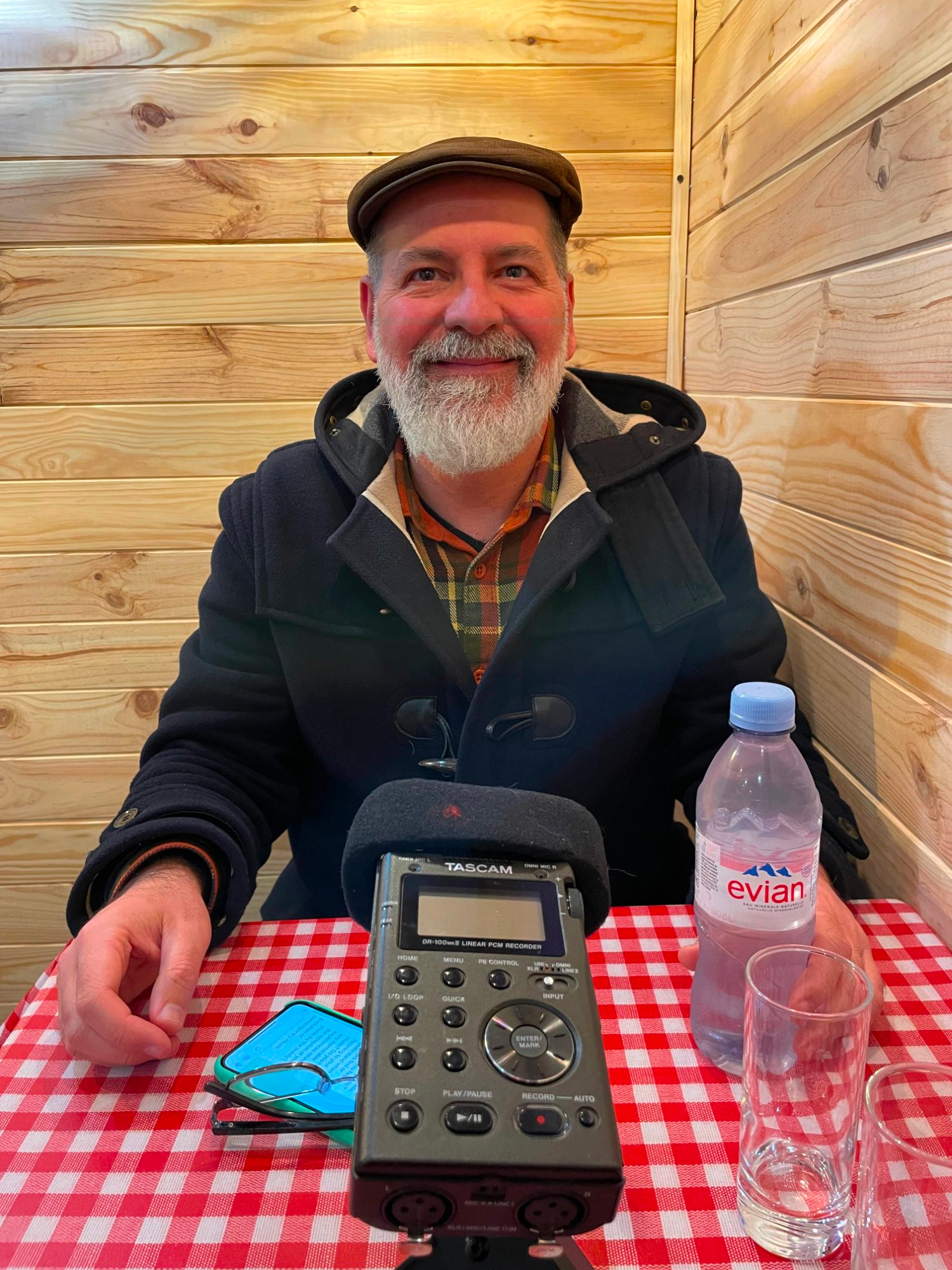
PB: What’s about your artistic journey and your background exactly, how did you get started in the world of music and contemporary art?
LC: It all happened through my first piano teacher in the Conservatory in my hometown, Sassari. I’m from the north of Sardinia, and when I enrolled to the conservatory there,
my first piano teacher was Gisella Frontero: a pianist/composer who was very actively involved in the contemporary music scene. Her father was from Liguria, but her mother was Sardinian, which is why she enthusiastically accepted her first conservatory job in such a remote place as Sardinia. She studied piano with Giancarlo Cardini at the Conservatory in Florence (Cardini was perhaps the most important piano player in the avant-garde scene in Italy, and collaborating with artists ranging from Paolo Castaldi, Walter Marchetti, but also Cage and Feldman).
When I became Gisella’s student, I think this was in her first assignment. From my first piano lessons, she would assign me, alongside pieces from the standard classical repertoire like Bach or, you know, Mozart or Haydn, also works for prepared piano by Cage, or some of the scores by Bussotti. She was in touch with all the prominent contemporary musicians from her generation particularly in Italy, but also abroad. She performed in New York at Roulette, and met John Cage, there… I mean Gisella has been a very important person for me, and I still owe her my current passion for music.
PB: And what are other influences that have shaped your artistic approach?
LC: Alongside composers like Luigi Nono, Scelsi and then Sciarrino, and American composers like Cage and Lou Harrison, I’d say that perhaps the most important composer for me was Sylvano Bussotti, with whom I interacted since the mid 1990s. When I moved to the United States, I invited him twice to the US, curating a number of events dedicated to him. So, I would say that the music of Sylvano was very important for me: his highly personal blend of serialism was something I just couldn’t so easily rebel against or toss it aside as I honestly could with most music coming from Darmstadt. I also admired his interdisciplinary approach: his ability of creating scores that had at the same time a tremendous visual impact. I think his Passion Selon Sade, or the ballet he wrote for his life partner Rocco, Bergkristall, are but two formidable examples of his astonishing gifts. I feel that even currently Bussotti is still a model for me: and I say this as I am now at the same time creating music but also working in the context of visual arts, which is why I’m here for Art Genève and I have this commission for ArtMonte-Carlo.
PB: That’s my next question: Can you tell us about one of your most memorable artistic projects and the relationship you have with the public, with the audience?
LC: So, among the most important for me, I’d definitely include the “Cena oltranzista nel castelletto al lago”: a three-days opera that requires the full cast to fast for the entire duration of the work. At the beginning of the opera, all performers—myself included—eat their last meal to then stop eating for two and a half days. The piece ends/culminates with a banquet, with which the performers finally break the fast and eat again.
This journey that the cast is doing, through music and performance art, all comes from a specific futurist source, the Futurist Cookbook, and from one chapter of it in particular, the one titled “Pranzo Oltranzista”. This opera was commissioned by the Festival Transart in Bolzano. Transart produced it together with Bolzano’s MUSEION. This three-days opera was entirely broadcasted live on the internet through MUSEION’s and Transart’s websites, but also through the website of the Performa Biennial in New York. Anybody could connect at any point with any of these sites during these three days and see online what the cameras were showing.
If I can say it, this opera really succeeded in merging experimental opera and reality TV. I would like to make an edited version of the 3-days broadcast: a film of about two and a half hours. That is going to be one of my next projects. This is certainly one of the projects of mine I am most fond of, because it’s in between fields/disciplines, and because this notion is connected with my study of futurism and my interests in synesthesia. Working in between artistic fields then, but also in between sensory fields: the aural (music), the visual (painting, or colors), etc. I just realized I have not answered about my relationship with the audience, and I even picked a project among many in which the only live audience is invited in the last three hours of the last day of the piece: during the banquet! Well, to speak about my relationship with the audience would require three days at least haha…
Impact of Artificial Intelligence
PB: How do you see the evolution of contemporary and experimental music over the years and the impact of artificial intelligence
LC: Well, I see with anticipation what is going to happen, because already we have been observing traces of artificial intelligence creeping up from all over. We are beginning to be exposed to all sorts of music produced that way. You can say, oh, I want to hear Yellow Submarine performed in the style of Rachmaninoff, and then AI apparently generates that. I just heard a hilarious AI-generated Billy Jean sung by Frank Sinatra that was quite entertaining and uncanny and it truly fooled a bunch of people I sent it to—Oh wow I didn’t know that Michael and Quincey covered a pre-existing song! —ha-ha. Of course, in visual arts it’s the same…
I mean, the easiest way of looking at this is to say that AI seems to be repackaging only things that already exist somewhere in the digital sphere. But if so, since when merely copying what’s in existence has been a proof of intelligence? My one liner about artificial intelligence is the following: “you can achieve artificially intelligence by making machines intelligent, but also you can achieve it by making people dumber.”
Jokes aside, I am yet to experience from AI anything that goes beyond pleasant or entertaining background music, let alone anything that is remotely mature, let alone moving. This is essential: if we as artists and audience members aren’t both after transcendence, what are we really doing? Merely generating material? Well, when it comes to transcendence, AI is for me unquestioning dropping the ball.
Why? It’s not merely an issue of kitschy sunsets or endlessly doodling minor 7 triads: the truth is that I refuse to let myself experience any of these noble emotions in response to AI content. I believe that AI just doesn’t deserve my effort.
most people, including myself, do not really want to waste the power of their brain and soul to create an emotional response to something that it isn’t human-made
Let me explain better. Many people mistakenly see art as a product, but in fact art is an exchange/feedback/love story between a work (with behind an intelligent creator) and a receiving intelligent entity (i.e. us). When we listen to, say, Schumann’s Kreisleriana, it’s not merely that the intelligence (genius) of Schumann permeates Kreisleriana, and so we as stupid listeners passively absorb it, and turn it into emotional food.
The reality is different: while listening Kreisleriana, our sensibility (brain) is actively engaged in absorbing it: we make all sort of assumptions about the composer and the work and ourselves (true or false, historical or anecdotical, real or imaginary, rooted in the biographical or the folklore around Robert Schumann and his literary persuasions etc…). All of what the composer of the piece may want to communicate to us is for us to lift. Our brain responds to the work by creating all sort of emotional reactions in us, and that’s truly some heavy lifting on our part.
The average art audience member, unaware of esthetics, is blind to what he or she is bringing to the art fruition table. Yes, Kreisleriana is beautiful, but we are author of a considerable part (not to prosaically quantify, but shall we say 50%?) of this beauty. Yes, the eye of the beholder blablabla…
So whenever we evaluate any AI generated work, we must remember that we will have to become the author of at least 50% of this emotional exchange.
Now, most people, including myself (call us stupid), do not really want to use (waste?) the power of their brain and soul to create an emotional response to something that it isn’t human-made. This is legitimate: I mean why waste this energy? Cui bono? Onan got punished by God for even less.
I don’t mind to make a mind effort and conjure-up my emotions when I know that at some point Schumann did that for me, and he came up with far more than an honest effort. But how does AI suffer? I am getting to my point, here: there is something slightly fraudulent/dishonest about this contract between an AI artist and its audience. With that I’d feel I’d be that mover carrying a grand piano up the stairs of a building: AI, my partner, is a few steps ahead: it is not really lifting much.
True, any assumption we make about Schumann and his psyche can’t conclusively be proved: maybe with that chord change he thought to convey that emotion in us or maybe he didn’t. We just cannot say: we are left lingering on those possibilities—something that is in itself endlessly charming. But in the case of AI we know conclusively that “it” doesn’t experience any emotion. AI can merely pretend to do that best that it can. But the fact that we know that, it makes the whole difference. The thrill is gone. AI simply doesn’t have any moral authority. “I’m not carrying that piano up the stairs by myself, dude!”
You asked about the future, and the only place I can see for AI music marketed as such is to entertain an AI audience. Then the issue of “effort” may disappear. Or a corporation could just lie about the product and its intentions, don’t disclose the fact that it was AI-generated, and see if humans dig it enough to top the views charts.
Naturally, here I am speaking of AI as a composer and say that by and large it’s really better if AI doesn’t think. However, if instead we consider using AI just to generate some material that a human composer could then elaborate, that may be a more compelling scenario. In that case AI would become a more elaborate version of a slot machine: straightforward, yes, but how intelligent is really that?
Noisemakers and Mysticism
PB: And we need to see the future. About Futurism and your relationship with Italian futurists, and Luigi Russolo particularly, can you talk about your interest in using Luigi Russolo’s noisemakers in your music? How does this instrument influence your approach to composition?
LC: So, well, I had the opportunity to recreate the first orchestra that Russolo designed. This was done in 2009, produced by the Performa Biennial. As of now I commissioned a lot of music to many composers for the instrument. I think this setup offers composers a very valuable opportunity to working with noise that are produced mechanically. Sure, it is true that also is limiting because you cannot produce any noise that you want. In the case of the intonarumori, that is the case. The intonarumori already make those noises, 16 of ‘em, and you can’t really generate others beyond that (naturally you can expand this palette to an extent using nonstandard techniques, but still).
Regardless, I think that composers typically benefit from restraints: this is the same as it would be with any other musical instrument. I mean the piano doesn’t do the things that the violin can do. If you press a piano key, you cannot fully control the volume envelope. The sound is not going to be fading in, or held at a constant amplitude, with a piano. Once the hammer hits the string, that’s it. That’s what you get. You can stop the sound, but you can’t shape it in terms of volume envelope. This restraint didn’t stop composers from writing for piano. One must see the glass half-full.
And so, I find that the composers that “get this” are the ones that write the best pieces for the setup, because yes, it’s not something that offers you a million of options; instead, it offers you something very specific, and all that is a plus. Also, I believe it is an interesting exercise, to deal with the technology from over a hundred years ago. This project has been great, and I learned a lot from conducting this music and writing for these instruments myself, too.
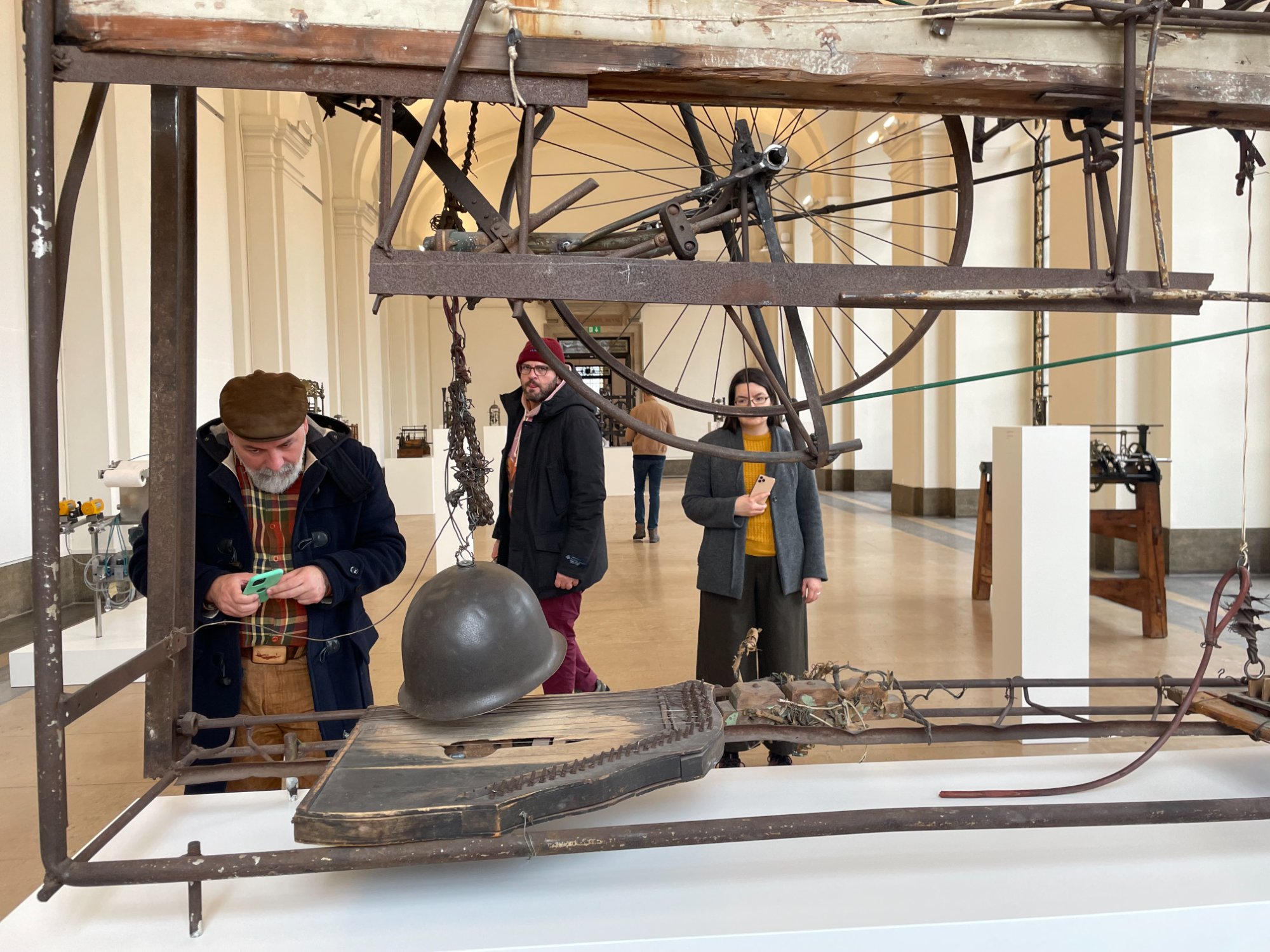
PB: You said something interesting. It’s not only music. You seem to link the invention of noisemakers by Luigi Russolo to a cult of Leonardo da Vinci and to a mystical or occult experience in a way the instrument, the noisemaker was not only to make music or sound. What is still your position today on that?
LC: Well, that is mostly the position of a researcher, meaning that I, when I researched on it, I was trying not just to say what I thought about the intonarumori, but also to offer the reader some insight on what Russolo thought of them. And whenever we look at the document, we cannot deny that Russolo really had these ambitions you just mentioned. He looked at the intonarumori beyond their mechanical features, and sought to project a spiritual value in them. Though this angle made most (all?) of his early critics clearly uncomfortable (was this Symbolist-infused attitude not Futurist enough?), I concluded that it would be misleading to approach these instruments—and Russolo’s history—without taking his view into consideration. Russolo’s approach to the intonarumori was by all means sacred. The category of spiritual was very important for him: he spent a lifetime researching on it, after all. Now, this passion really marked his creative impulse. And so, if I’m going to write about Russolo and explain to somebody else what Russolo was about, I surely cannot take this part out. I argue in my book that it was from this position that the instrument got produced. Given that he created the intonarumori from these ambitions and desires, when we look at them from an historical perspective, we have to come to terms with Russolo’s own vision of what his art of noises was. Plus, this was not even “his” vision. I believe in my book I succeeded in proving that not just Russolo personally, but the whole Futurist milieu—Boccioni, Paolo Buzzi, Marinetti—all describe the art of noises in similar occult terms.
PB: And you are the first one to say that! On another subject, my main dream is to discover a version of the Rumorharmonium in a cellar, and no doubt it is your dream too. Do you have any idea what this instrument could have been? Because we know little about it, other than that it was made up of several noisemakers...
LC : So he did several versions of this instrument. The very first one, the legend said, was done in Thiene. He was in Thiene working on a project after World War I, where the government of Italy was paying people to dismantle some section of the railroad. So, the legend says, in the time when he was there Russolo had acquired some of this material from trains and trucks, which he used to build the first version of the Rumorharmonium. There are photographs of Russolo in Thiene playing this instrument, and the version that he’s playing, the first version of it, truly looks like a harmonium. He likely started adapting a harmonium cabinet. This first version has a standard organ keyboard. So, to begin with the instrument looks like a harmonium that is controlling various noises with a keyboard interface.
Russolo was obviously dissatisfied with the earliest incarnation of the Rumorharmonium because the intonarumori were born out of the desire of creating instruments that—in his words—were enharmonic, which means that the instrument will move from one note to the next by way of a glissando. Naturally, the piano is the opposite of that. I mean, even in the 1916 “Art of Noises” book, he really speaks passionately against the division of the octave in semitones. And then there we see him playing an instrument that has a keyboard divided into semitones! Well, I think this was just a compromise. He must have found a harmonium and thought to modify it to produce noises instead of ordinary tones. But he worked on this incessantly, so the instrument that he used in Paris is nothing like the instrument built in Thiene. The instrument from Thiene got moved to Milan. In Milan he kept working on it. From there he shipped it to Paris, but in Paris it arrived severely damaged. This was not a disadvantage for Russolo because he likely was already thinking of making another version of it. If I’m not mistaken, he made four version of this instrument. So, the instrument that he had played in 1929 for his presentation at La Sorbonne that was keynoted by Edgar Varese — likely the last version of the Rumorharmonium — had full microtonal capabilities. This instrument had no keyboard, and levers replaced the keys. Unfortunately, there’s no patent for this instrument, only a partial photograph: so, it’s very hard to make it up how exactly it functioned internally.
PB: We have only text but no sound.
LC: Yeah, exactly, beyond what he said already.
PB: That’s the problem with Luigi Russolo ultimately. Because even the experiences of Rosanna Maggia who made fake music by Luigi Russolo and she was very proud of that… but people were confused and how can I say... being an alchemist, making new music in the style of Luigi Russolo and to be not recognized, it’s difficult. Perhaps you have the same ambition to create new music that could have been made with noise makers ?
LC: Right.
Russolo and Fascism
PB : And last question, I understand your position about Giovanni Lista who said that Luigi Russolo was anti-fascist. My perception is that Luigi Russolo was not interested in political issues. But according to you, do you think that Russolo was a fascist activist? What was the relation between Russolo and the Fascism?
LC : It is a complex question! I believe any answer first needs to address the relation between Fascism and Futurism at large, something which perhaps can be studied by observing the love-hate relationship Marinetti had with Mussolini. That relationship was marked by contention, by envy, and certainly by resentment on Marinetti’s part, because Mussolini took many of Marinetti’s ideas to then create his own—and alas rather successful—political party. When Mussolini clearly emerged as the unquestioned leader, Marinetti was forced to step on the side—not something of Marinetti’s liking. Surely Marinetti must have felt used, but up until the bitter end, there was resentment but there was love. They were, after all, frenemies for life.
Now, while Marinetti participated in Fascism, Russolo did not, and for one very simple reason: after WWI he was physically utterly unable to participate to any kind of political action. He was wounded in the head in 1917 in combat, during the “battaglia d’Arresto”, and hospitalized, and paralyzed for about a year. By the time he regained consciousness, he was not the same person. In fact, I believe that Russolo never fully recovered from the injury; he kind of coped with that for the rest of his life. Proof of that is the fact that he wasn’t capable of conducting the 1921 intonarumori concerts in Paris. And it’s not so much that Marinetti wanted to hire his brother: Russolo is physically incapable to conduct, he’s unfocused, likely still shell-shocked and he needs somebody else to do it. So, he tells Marinetti, well, my brother will do it instead of me. True, the Parisian repertoire also required a more traditional training, but such repertoire could have been picked due to the fact that Russolo was still unwell, as one can even see in the photographs. There, he’s present but looking rather weak, walking with a cane, clearly lacking the same strength that he had before the war.
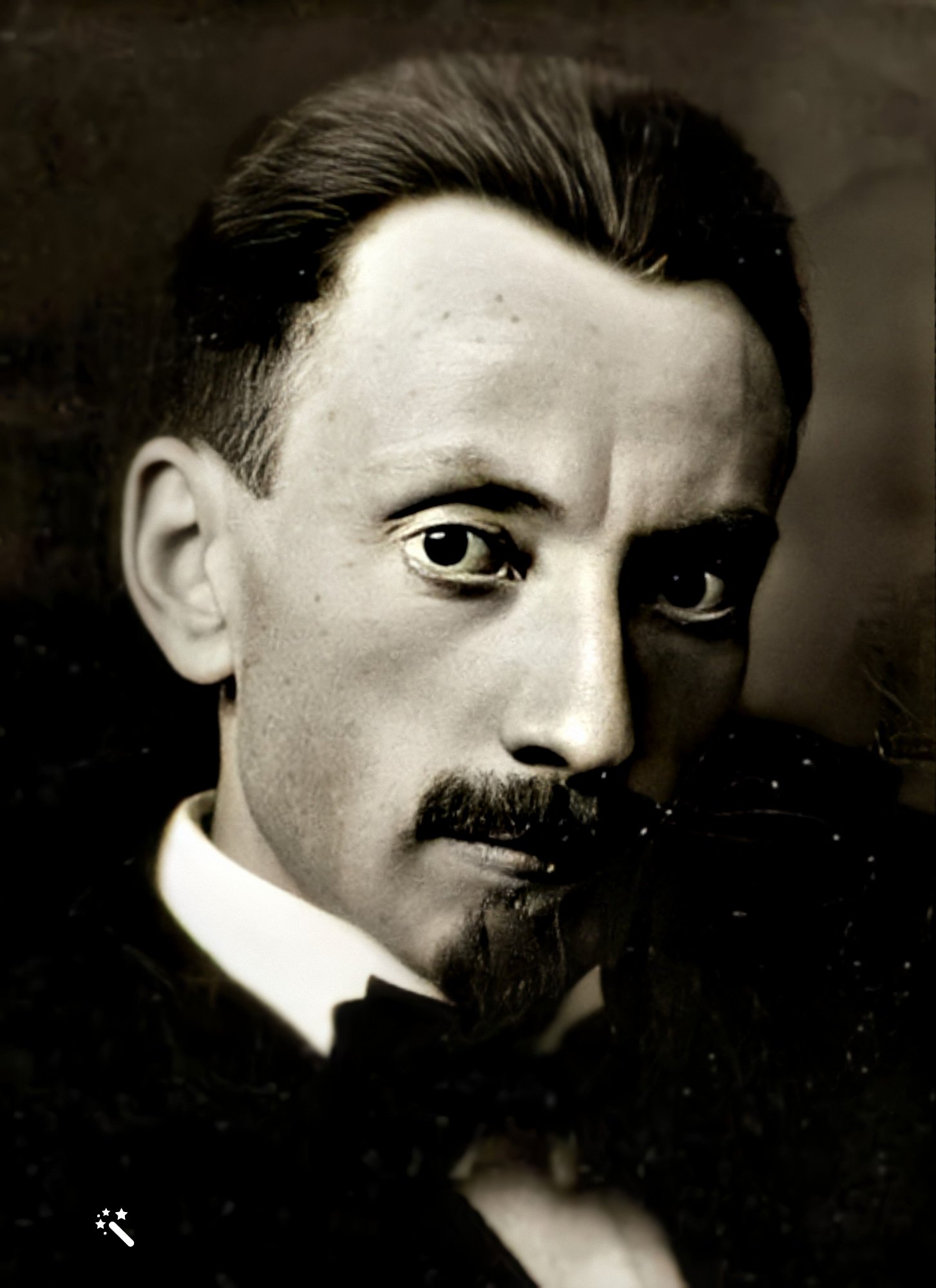
We don’t know how Russolo’s political position would have evolved, had he been able to physically follow Mussolini and Marinetti through their public activities in the year 1919, the year Fascism was founded. But really, it’s pointless to look at history that way: reality just went in a different direction.
On the other hand, fascist militancy required a kind of involvement that was based on physical action. This was particularly the case in the moment when Fascism came to be, in the highly turbulent years immediately after World War I, the so-called biennio rosso. These were years of intense political participation, a participation that was also physical, with street rallies and such. At exactly that historical moment, Russolo was incapacitated, still recovering.
We don’t know how Russolo’s political position would have evolved, had he been able to physically follow Mussolini and Marinetti through their public activities in the year 1919, the year Fascism was founded. But really, it’s pointless to look at history that way: reality just went in a different direction. We can speculate endlessly on the “oh if Russolo wasn’t hit in the head, maybe he would have participated to the 1919 burning of the socialist newspaper’s L’Avanti’s headquarters, of he would have been present in Milan’s Piazza San Sepolcro when Fascism was founded, and all that: but the fact of the matter is that we know he didn’t do any of it: he couldn’t do any of it because he was unable to.
For years I studied Russolo’s relationship with fascism, mapping it all in details. I lectured on it, but I haven’t published this research yet. Frankly, I am not even convinced that it’s that important to do so. I’m not so sure it’s that that urgent. In a way, what matters—that Russolo was not an antifascist—I have already stated in lectures and published it in my book. Providing a detailed analysis of his politics isn’t probably that necessary or interesting. I look at his position as the classic example of a citizen trying to survive during a dictatorship. Above all, in the fascist Ventennio (1922-1943), Russolo chose to concentrate on his research.
When living under a dictatorship, while not everyone is a cheerleader, not everybody is a hero either. Sure: there are people who have the energy to fight or feel protected enough to do so or have nothing to lose and so they can openly say “I disagree”; and there are people (the vast majority, unfortunately) who are just basically accepting the status quo and they’re focusing on their work, on surviving. Marinetti did voice his opinions during fascism: a few positions were even in conflict with Mussolini, though mostly were in agreement.
If pre-WWI Russolo was rather politically-active, post-WWI Russolo didn’t much manifest publicly his political ideas.
Being physically unable, he didn’t shout in squares his favor for Fascism, but he couldn’t be in the barricade against it either.
Was he an anti-fascist? I don’t believe he was.
An anti-fascist would be someone like Matteotti, whose political murder was ordered by Mussolini. An anti-fascist would be someone like Antonio Gramsci, who pays for it: goes to jail and dies there for it.
Russolo wasn’t like that. He never was antifascist, and stating otherwise is a manipulation of facts. The various testimonies Lista gathers to attempt to prove Russolo’s antifascism are understandable for the time Lista is writing them, but they are all ultimately false: I have publicly exposed the unreliability of each one of them in my Melbourne talk.
Not being anti-Fascist doesn’t automatically make you an ardent Fascist either, like anyone who has ever lived under a dictatorship will readily tell you. Truth is: in a country under a dictatorship, the vast majority of the people, for the better or the worse, take a middle ground position, a position of convenience, probably not morally admirable. This is justifiable. People are usually preoccupied with their livelihood, or worried about the well-being of their children, etc. There’s a joke attributed to Churchill: “before WWII 90% of the Italians were fascist, and after the war 90% of the Italians were anti-fascist”. Like, how could this be? This is not adding up! Hahah !
PB: Do you think that if Marinetti had seen the war like Russolo, his ideas would have been different?
LC: I mean, Marinetti went to war, too, but he never really was engaged in combat, as far as I understand. Russolo was, and we know what happened...
PB: But also, Marinetti changed his mind.
LC: Mmm not entirely sure. He did go to WWI, and he did still want to participate in WW II. I believe he even enlisted in it, though this adventure was cut short because he wasn’t physically fit for it anymore.
I agree on one thing: Marinetti could more easily glamorize WWI (and on that ground he could more easily continue being politically active right after the war) because he truly observed the war from a distance, from his hotel room. Someone like Russolo, who was active on the battlefield and saw death in the eyes, got wounded, and became permanently disable because of that, I am sure had a harder time glamorizing war.
Some of the early fascist fuel came from the movement of the Arditi. WWI veterans, the Arditi felt dissatisfied with the end-result of the conflict: they felt betrayed by war as they didn’t feel their sacrifices paid off. They felt wronged by the League of Nations. Gabriele D’Annunzio famously spoke about the end of WWI from the Italian perspective as a mutilated victory.
As a WWI veteran, Russolo could have been the perfect candidate to be part of the Arditi, but after his months-long hospitalization, he did no longer have the physical ardor to do that. Probably too much trauma, for him. Meanwhile as I said the Fascist movement was launched, and having he missed the first episode, he ended up non really going for the whole series. His attention drifted away. He turned his full attention to his own work and let others do political activity.
PB: I see: Russolo was out of the picture, politically because he was injured in the war, he was not the same anymore.
LC: Yes: as I said, he misses the key year: when all the roles were assigned. But it doesn’t matter, since he never fully recovered from the injury. So he put his energy into his work.
PB: And even before the war, Luigi Russolo was very friendly with Umberto Boccioni with whom he had passionate discussions about Art... But he did not seem to be a leader!
LC: No, but he signed all pre-WWI political manifestos! Also, Russolo had quite the temper, like the story of his public slapping to Cameroni and the resulting trial tells us.
But just because he was a rowdy Futurist in 1910, this doesn’t automatically mean he was a Fascist at that time, or he was going to become one. Such simplistic position would amount to read history backward. Maurizio Calvesi already in the 1960s argued that a more useful hermeneutical view of Futurism is to interpret it as a movement that’s been propelled by the energy of the Italian Risorgimento, as opposed to reading history from the WWII fiasco, moving backwards.
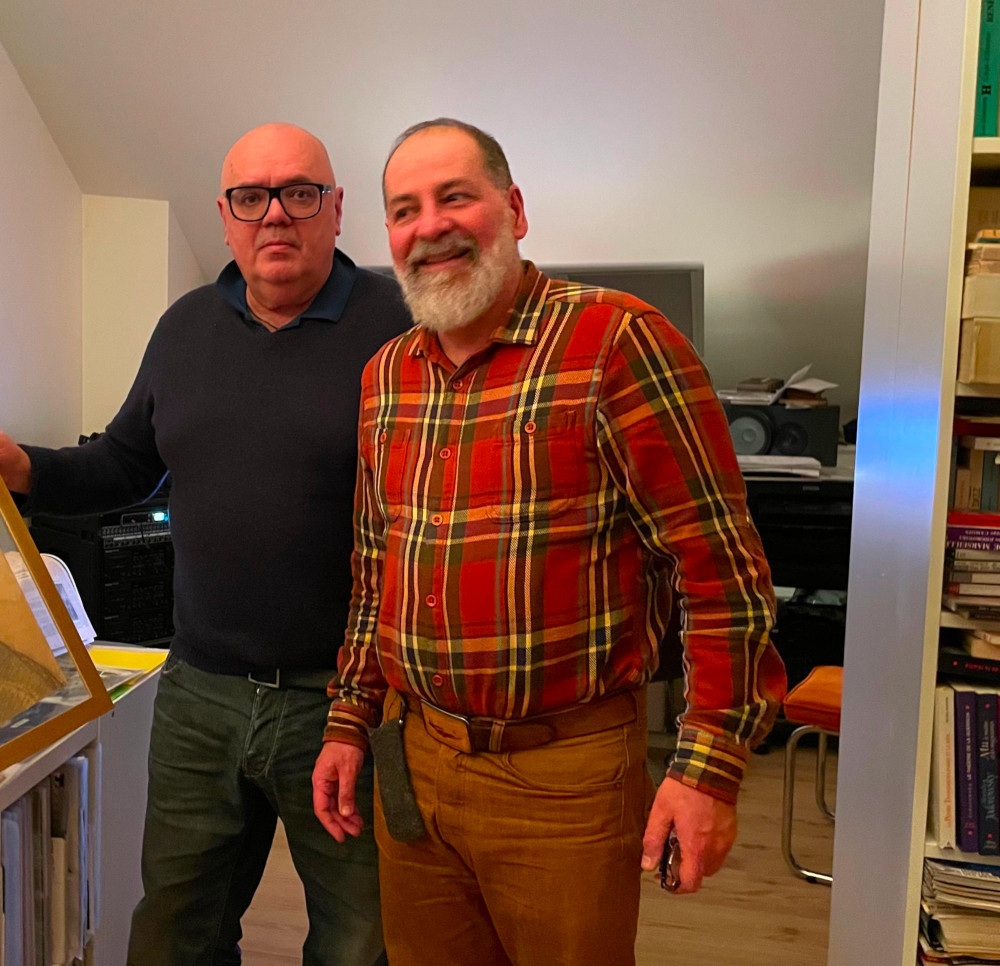
Fascism is a political force that emerges after WWI. It has a beginning. It has a founder. Also, Fascism truly only makes sense when it’s placed in its historical context.
While I do know that nowadays, especially in social media, the word Fascism is constantly dropped, and so frequently abused that it ceases to have any meaning at all—when you say Taylor Swift is Fascist, The Super Bowl is Fascist, Kanye West is Fascist, Trump is Fascist, Biden is Fascist you start to say nothing at all—I still prefer to stick to its definition. Therefore I must point to the fact that speaking of pre-WWI Fascism does not make any historical sense. This also means that I disagree with the idea that the 1913 art of noise manifesto articulates any fascist position. True, the desire for renewal of artistic means of expression found in this (and other) Futurist manifestos is presented in blunt and sometime aggressive terms, but this is really typical of every youth movement, be that the Scapigliati, Dada, Fluxus, Punk, or Gangsta-rap etc. Besides, Fascism didn’t created/copyrighted violence. If only was that simple….
Annecy, 26th of January 2024 – Icone Hôtel, Annecy
- Music For 16 Futurist Noise Intoners
- Performa is delighted to present “Music For 16 Futurist Noise Intoners,” an evening-length concert of original scores and newly commissioned compositions for the intonarumori, or “noise-intoners” As part of its celebration of the 100th anniversary of Italian Futurism, the Performa 09 biennial, in collaboration with the Experimental Media and Performing Arts Center (EMPAC) and SFMOMA, has invited Luciano Chessa to direct a reconstruction project to produce accurate replicas the legendary instruments (8 noise families of 1-3 instruments each, in various registers) that Russolo built in Milan in the summer of 1913. As the first instruments capable of creating and manipulating noises through entirely mechanical processes, the intonarumori can be considered to be the original analog synthesizer, and the ancestors to the latest electronic synthesizers used today.
With Blixa Bargeld, John Butcher, Luciano Chessa, Joan La Barbara, Nick Hallett, Pauline Oliveros, Mike Patton, Anat Pick, Elliott Sharp, Ulrich Krieger, Jennifer Walshe with Tony Conrad, Ghostigital with Skuli Sverrison, Finboggi Petursson, and Casper Electronics.
Chessa will present the first modern live performances of two early Futurist pieces—the legendary fragment from Russolo’s spooky “Risveglio di una città” (1913), and “La pioggia nel pineto antidannunziana,” a newly-discovered 1916 piece for intonarumori and “Words in Freedom” by Futurist playwright and poet Paolo Buzzi—as well as “L’acoustique ivrese”, his brand new composition for 16 intonarumori and voice on a poem also by Buzzi. An incredible group of musicians and composers from the experimental music world—including Einstuerzende Neubauten frontman and Nick Cave collaborator Blixa Bargeld, avant-garde saxophonist John Butcher, Deep Listening pioneer Pauline Oliveros, Faith No More and Mr. Bungle vocalist Mike Patton, sound and text-based performer Anat Pick, avant-garde musician Elliott Sharp, and composer and vocalist Jennifer Walshe collaborating with composer and film/video artist Tony Conrad, among others—have been commissioned by Performa to create and perform brand new compositions for the instruments.
A Performa Commission with SFMOMA and EMPAC. Produced and presented by Performa. Curated by Luciano Chessa with Esa Nickle. Thanks to AIR, Art International Radio and the Clocktower Gallery for rehearsal spaces.


